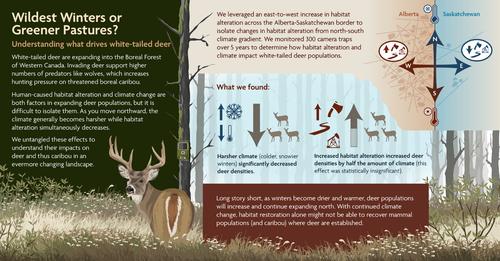当前位置:
X-MOL 学术
›
Glob. Change Biol.
›
论文详情
Our official English website, www.x-mol.net, welcomes your feedback! (Note: you will need to create a separate account there.)
Habitat alteration or climate: What drives the densities of an invading ungulate?
Global Change Biology ( IF 11.6 ) Pub Date : 2024-04-25 , DOI: 10.1111/gcb.17286 Melanie Dickie 1, 2, 3 , Robert Serrouya 1 , Marcus Becker 3 , Craig DeMars 1 , Michael J. Noonan 2, 4, 5 , Robin Steenweg 6 , Stan Boutin 7 , Adam T. Ford 2
Global Change Biology ( IF 11.6 ) Pub Date : 2024-04-25 , DOI: 10.1111/gcb.17286 Melanie Dickie 1, 2, 3 , Robert Serrouya 1 , Marcus Becker 3 , Craig DeMars 1 , Michael J. Noonan 2, 4, 5 , Robin Steenweg 6 , Stan Boutin 7 , Adam T. Ford 2
Affiliation

|
Anthropogenic habitat alteration and climate change are two well‐known contributors to biodiversity loss through changes to species distribution and abundance; yet, disentangling the effects of these two factors is often hindered by their inherent confound across both space and time. We leveraged a contrast in habitat alteration associated with the jurisdictional boundary between two Canadian provinces to evaluate the relative effects of spatial variation in habitat alteration and climate on white‐tailed deer (Odocoileus virginianus ) densities. White‐tailed deer are an invading ungulate across much of North America, whose expansion into Canada's boreal forest is implicated in the decline of boreal caribou (Rangifer tarandus caribou ), a species listed as Threatened in Canada. We estimated white‐tailed deer densities using 300 remote cameras across 12 replicated 50 km2 landscapes over 5 years. White‐tailed deer densities were significantly lower in areas where winter severity was higher. For example, predicted deer densities declined from 1.83 to 0.35 deer/km2 when winter severity increased from the lowest value to the median value. There was a tendency for densities to increase with increasing habitat alteration; however, the magnitude of this effect was approximately half that of climate. Our findings suggest that climate is the primary driver of white‐tailed deer populations; however, understanding the mechanisms underpinning this relationship requires further study of over‐winter survival and fecundity. Long‐term monitoring at the invasion front is needed to evaluate the drivers of abundance over time, particularly given the unpredictability of climate change and increasing prevalence of extreme weather events.
中文翻译:

栖息地改变或气候:是什么驱动了入侵的有蹄类动物的密度?
人为栖息地改变和气候变化是通过改变物种分布和丰度而导致生物多样性丧失的两个众所周知的因素;然而,理清这两个因素的影响往往会因其在空间和时间上固有的混乱而受到阻碍。我们利用与加拿大两个省之间的管辖边界相关的栖息地改变的对比来评估栖息地改变和气候的空间变化对白尾鹿的相对影响。维吉尼亚小蠊 )密度。白尾鹿是一种入侵北美大部分地区的有蹄类动物,其向加拿大北方森林的扩张与北方驯鹿的减少有关。驯鹿 ),该物种在加拿大被列为受威胁物种。我们使用 12 个重复的 50 公里范围内的 300 个远程摄像机估算了白尾鹿的密度2 超过5年的风景。在冬季严酷程度较高的地区,白尾鹿的密度明显较低。例如,预测鹿密度从 1.83 头/公里下降到 0.35 头/公里2 当冬季严重程度从最低值增加到中值时。随着栖息地改变的增加,密度有增加的趋势;然而,这种影响的程度大约是气候影响的一半。我们的研究结果表明,气候是白尾鹿数量的主要驱动因素。然而,了解支撑这种关系的机制需要进一步研究越冬生存和繁殖力。需要对入侵前沿进行长期监测,以评估随时间变化的丰度驱动因素,特别是考虑到气候变化的不可预测性和极端天气事件的日益普遍。
更新日期:2024-04-25
中文翻译:

栖息地改变或气候:是什么驱动了入侵的有蹄类动物的密度?
人为栖息地改变和气候变化是通过改变物种分布和丰度而导致生物多样性丧失的两个众所周知的因素;然而,理清这两个因素的影响往往会因其在空间和时间上固有的混乱而受到阻碍。我们利用与加拿大两个省之间的管辖边界相关的栖息地改变的对比来评估栖息地改变和气候的空间变化对白尾鹿的相对影响。



























 京公网安备 11010802027423号
京公网安备 11010802027423号